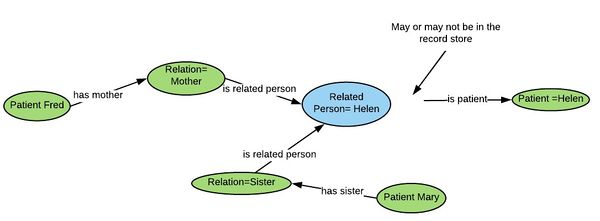Family relationships and none professional relationships between people, are included in the common information model in two main ways:
- An ontology of relationships, using relationship types and person as a 'relation' subclasses, the latter being aligned with the Snomed-CT 'Person' subclasses with additions for in-laws.
- The data model, whereby a [related person] is linked to another person transitively via a relationship type and relation entity, the latter being aligned with the above.
As with the common information model in general, the two are related to each other so an enquirer can build sophisticated relationship queries and advanced family trees. Most people would struggle with understanding who their third cousins were, yet they are genetically quite close.
Relationships appear complex to model because of the ambiguous way the terms are used in plain language.
For example a "mother" is a person who is a mother of somebody. A son "has a mother" who is a mother. However, the same person who is a mother may also be a "sister" (whether or not the relationship to her sister has been authored). Consequently, there is a need not only to model the relationship between people (using a sub property of "related to"), but also to model the relation as a role independently of the relationship itself. The introduction of the role entity along the path of the relationship resolves the difficulty.
An additional complication is that a related person may or may not be a patient or person recorded in the record store. It may be someone unknown or abroad and there may be little information on them other than a contact detail. Therefore the related person also has to be modelled as an entity separately from patients. These classes and properties can be illustrated as follows:
Thus there are 4 potential entity types in a relationship
a) The source patient (the person who has the relationship with someone else)
b) The role of person who is the relation e.g. Mother, Carer, Sister.
c) Information about that person, which would be the same, whatever relation they were to other people.
d) Another patient in the record store i.e. where the person is also a patient.
It is possible to model all links between people as relationships of this kind. However, in practice most relationships can be more direct e.g. the subject of an observation being a patient, or an encounter being performed by a doctor. In the common model these more obvious ones are modelled as direct relationships. Relationships of the kind modelled above are reserved for family relationships or non professional relationships such as carers.
